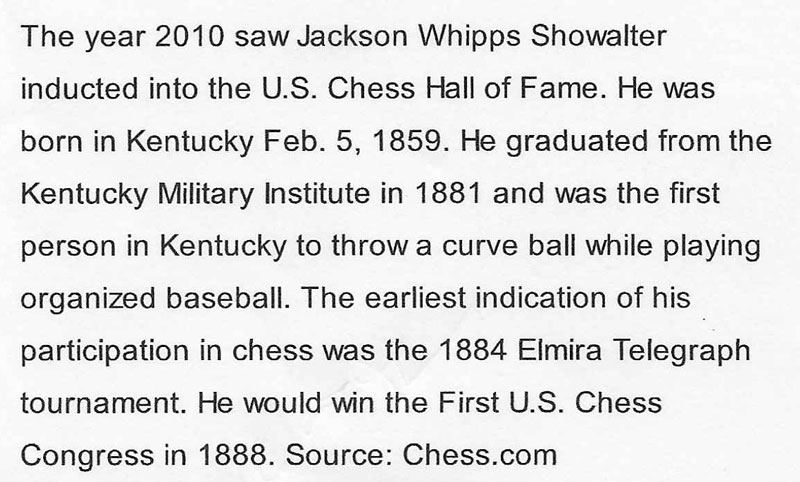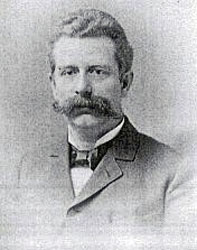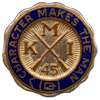|
Jackson Whipps Showalter
KMI Class of 1881  contributed by John Elvis Williams, Class of 1953 |
|||
| He
was known as "the Kentucky Lion" after his birthplace and his
hairstyle, which consisted of a thick mane down the back of his neck,
and perhaps also his playing strength. His wife Nellie was one of
America's leading female players, who won a match against Emanuel
Lasker at knight odds 5-2. A variation of the Queen's Gambit Accepted is named after him (1. d4 d5 2. c4 dxc4 3. Nc3). The famous "Capablanca Simplifying Manoeuvre" in the Orthodox Variation of the Queen's Gambit Declined (1.d4 d5 2.c4 e6 3. Nc3 Nf6 4. Bg5 Be7 5. e3 Nbd7 6. Nf3 0-0 7. Rc1 c6 8. Bd3 dxc4 9. Bxc4 Nd5) had in fact been used by Showalter in the 1890s, many years before José Raúl Capablanca played it. He was inducted in the World Chess Hall of Fame on August 7th, 2010. His great grand daughter, Amy Showalter attended the ceremony and accepted the plaque on behalf of the Showalter family. The content of the induction speech was supplied by Kevin Marchese of Columbus, Ohio, who is currently writing a biography on Showalter that is slated to be delivered in late 2016. (Source – Wikipedia The Free Encyclopedia /Picture: Wikipedia The Free Encyclopedia) ______________________________________________________________________________________________________ by Kevin Marchese Chess.com Jackson W. Showalter, Herman Steiner, and Diane Savereide are all being inducted to the U.S. Chess Hall of Fame this afternoon in Irvine, CA (USA). I am still working on the manuscript for the Showater book and hope to have it completed by Spring of 2011. Because of my Showalter research, I was asked by the hall of fame director to write a brief summary on the life and chess of Showalter for the induction ceremony and would like to share it here with the chess.com community: Jackson Whipps Showalter was born February 5th, 1859 in Minerva (Bracken County), Kentucky. His parents, Freeman Benoni Showalter and Margaret Rachel (Whipps) Showalter, were farmers who migrated from Smithfield (Fayette County), Pennsylvania. He was the youngest of three boys, along with James Watterson Showalter and John William Showalter. The latter went on to be a famous Supreme Court circuit judge in Chicago, Illinois. Showalter graduated from Kenyon College (1879) in Ohio and would later graduate from the Kentucky Military Institute (1881) in Frankfurt, Kentucky. Some sources report that he and his brothers were also ranchers in Laredo, Texas for a short time. Other sources indicated that while playing organized baseball with various travelling teams in Kentucky, Showalter was one of six or seven individuals to invent the curve ball or at the very least, the first person in Kentucky to throw a curve ball. He would eventually settle in Georgetown, Kentucky. Family legend has it that he rode into town on his horse and attended a land auction in which he purchased a 325-acre farm for $29,000. When asked to make arrangements for payment, he reached into the saddle bags atop his horse and handed them cash. This farm would be the location of Showalter’s successful tobacco business for many years to come. Showalter met Nellie Love Marshall in the early 1880’s and would go on to marry her in 1887 in Donerail, Kentucky. This is the same period that his chess career began to be noticed in documented periodicals, with the earliest records indicating his participation in the 1884 Elmira (New York) Telegraph tournament and the 1887 New York Chess Club championship. In September of 1888, various representatives of the State Chess Associations met in Cincinnati, Ohio to form the United States Chess Association. Showalter was chosen to be on the first executive committee for this newly formed organization. This also turned out to be the time and place for the 1st U.S. Chess Congress, which Showalter won with a score of 8 wins, 0 losses, and 2 draws. The following year he played in the 6th American Chess Congress (no affiliation with the aforementioned tournament) in New York. The tournament attracted many of the greatest chess players of the era from all over the world. He finished a respectable 9th out of 20 players in the field. Showalter would go on to win two more U.S. Chess Congress tournaments in 1890 (St. Louis) and 1891 (Lexington). Combined with his victory in 1890 at the Chicago tournament, his cumulative record over the course of these three victories was an impressive 29 wins, 2 losses, and 1 draw. Despite being ill with influenza, Showalter played and lost a hard-fought match (+2 -6 =2) to future world champion Emanuel Lasker of Germany in 1892-93. Lasker was quoted after the match as saying that Showalter gave him the hardest battle of his life. He even went on to say “No man in all my experience ever stood up with such a formidable front as the talented Kentuckian. He is the greatest player I ever met.” Nellie (Showalter’s wife) was an excellent chess player in her own right, actually defeating Lasker in a casual match with the advantage of knight odds (+5 -2 =0). She would later earn the title of U.S. Ladies Champion with her match victory over Harriet Worrall in 1894. There is much controversy and speculation as to when Showalter first captured the title of U.S. Chess Champion. Some sources have him as champion in 1890 as a result of his tournament victory at St. Louis, coupled with the inactivity of proposed champion Samuel Lipschutz. Others claim his match victory over Max Judd in 1892 (+7 -4 =3) was for the title. Even his win over Albert Beauregard Hodges (+7 -6 =4) in 1894 has been considered controversial. The only title win that seems to be amicable to most historians is his 1895 conquest of Lipschutz (+7 -4 =3). He would successfully defend his title twice in 1896 by defeating both Emil Kemeny (+7 -4 =4) and John Finan Barry (+7 -2 =4). In 1897 he faced the up-and-coming Harry Nelson Pillsbury in arguably the greatest chess match in United States Chess Championship history. Showalter was one victory away from retaining his title against his heavily favored opponent and had the White pieces for the potentially deciding game. In a sixty-move Ponziani opening, Pillsbury was able to prevail and eventually won the match in an extended overtime by the score of 10 wins, 8 losses, and 3 draws. Showalter sought to re-capture his title the following year against Pillsbury, losing in less dramatic fashion by the score of 3 wins, 7 losses, and 2 draws. During the next three years Showalter travelled abroad to Europe and participated in several international chess tournaments, with mildly disappointing results. Then, after finishing 2nd at the Manhattan Chess Club championship in 1900 to Lipschutz, Showalter went into a retirement of sorts until the 1904 Cambridge Springs international tournament. This would be the greatest collection of chess masters on American soil since 1889 (Sixth American Chess Congress) and briefly drew Showalter back to competitive chess. He would finish a very respectable 5th out of 16 against the impressive likes of Frank Marshall, David Janowski, Emanuel Lasker, Carl Schlechter, Mikhail Chigorin, and Richard Teichmann. What had to be even more satisfying for Showalter was that he finished ahead of Pillsbury and also defeated him in their only encounter of the tournament. Showalter then disappeared from the chess world for the next several years. Pillsbury tragically passed away in 1906 at the early age of 33. This meant that the U.S. title now defaulted to the previous champion, the retired Jackson W. Showalter. In 1909, Frank Marshall was overwhelmingly the strongest American player of the time and given that Showalter had stopped playing competitively five years previously, the title was somewhat in limbo. It was ultimately decided that Showalter would either defend his title against the much younger Marshall or relinquish it of his own accord. Showalter decided to play and was eventually overcome by the score of 2 wins, 7 losses, and 3 draws. He took yet another hiatus of six years after losing the match, returning at the 1915 Western Open in Excelsior, Minnesota and promptly winning first place. He then stayed active in chess for several years, playing in the strong Western Opens (2nd place in 1916 and 1917). His last tournament was the 1926 Western Open in Chicago at the ripe old age of 67. He finished toward the bottom of standings, but was able to muster up one more brilliant win against strong American player, Edward Lasker. Showalter happily lived out his remaining years surrounded by family at his Georgetown farm. He was often seen on the rooftops in town or out in his field with a table and board, playing chess with friends and family. He passed away on his birthday (February 5th) in 1935 at the age of 76. Jackson W. Showalter loved life, family, chess, and cigars. He was also very well liked and respected by his counterparts. Former world champion William Steinitz was once affectionately quoted as saying that Showalter was “one of only six men from whom he would accept a cigar.” |
|||
|


